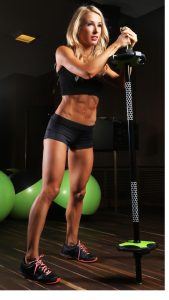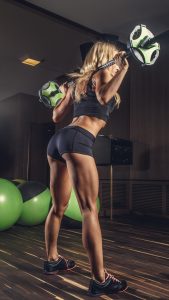Squats are a fantastic compound exercise, but the stance you choose can significantly impact your form and muscle engagement. When it comes to using a barbell and being a female athlete, there’s a lot to consider about stance and its effects.
The Right Stance: Squatting with a Barbell for Women

Understanding Squat Stances
Squat stances vary from wide to narrow, each targeting different muscle groups. A narrow stance generally emphasizes the quadriceps, allowing for greater depth in the squat. This stance involves placing your feet closer together, usually around hip-width or slightly narrower.
Barbell Squats and Female Athletes
For women specifically, there’s no one-size-fits-all approach. Body structure, flexibility, and fitness goals play crucial roles in determining the optimal stance.
Narrow Stance Considerations
Targeted Muscles: A narrow stance can effectively engage the quadriceps, promoting muscle development in the front of the thighs.
Depth and Control: It often allows for deeper squats while maintaining better balance and control.
Joint Stress: Narrow stances might put more stress on the knees, so it’s crucial to ensure proper form and not exceed your comfort zone.
Other Factors to Consider
Hip Mobility: A narrower stance demands better hip mobility, which might vary among individuals.
Personal Comfort: Some find a narrow stance more natural and comfortable, allowing for better performance.
Finding Your Stance
Experimentation: Try various stances to determine what feels most comfortable and effective for you.

Consultation: Seek advice from fitness trainers or professionals who can analyze your form and suggest the best stance for your body.
So.
The debate over squat stance, especially with a barbell, is multifaceted. While a narrow stance can benefit certain muscle groups and allow for deeper squats, it’s not a one-size-fits-all solution. For women using a barbell, it’s crucial to find a stance that balances effectiveness, comfort, and safety.
Remember, your unique physiology and fitness goals should dictate the stance that works best for you. So, don’t hesitate to experiment and seek guidance to optimize your squatting experience.
Let’s delve deeper into the nuances of squat stances, especially concerning women and barbell use.
Exploring Barbell Squat Stances for Women
Wide Stance vs. Narrow Stance
Wide Stance: A wider stance in squats often engages the glutes and hamstrings more prominently. For some women, this can provide a more stable base, especially when lifting heavier weights.
Narrow Stance: As discussed earlier, this stance emphasizes the quadriceps and might allow for deeper squatting. However, it might require better flexibility and control.
Addressing Concerns
Knee Alignment: Regardless of stance, ensuring proper knee alignment is crucial to prevent stress or injury. The knees should align with the toes, not collapsing inward or pushing too far forward.
Safety and Support: Using a barbell demands core engagement and proper spinal alignment. Regardless of stance, focus on maintaining a neutral spine and activating the core muscles for support.
Tailoring Stance to Fitness Goals
Strength vs. Hypertrophy: Your fitness goals might influence your preferred squat stance. For instance, if aiming for hypertrophy (muscle growth), you might experiment with different stances to target specific muscle groups.
Athletic Performance: Athletes might opt for stances that mimic movements in their sports. For instance, a sprinter might benefit more from a wider stance to engage the posterior chain.
The Role of Progression and Adaptation
Gradual Adjustments: When altering your squat stance, make gradual changes to allow your body to adapt. Sudden shifts can affect your form and lead to discomfort or injury.
Consistency and Observation: Stay consistent with your chosen stance for a few workouts, observing how your body responds and the muscle groups engaged.
The Impact of Individual Factors
Body Structure: Individual anatomical differences influence squat mechanics. Females, in particular, might have wider hips, which can affect the ideal stance.
Injury History and Comfort: Previous injuries or discomfort in specific positions should also guide your choice of squat stance.
Conclusion
The optimal squat stance with a barbell for women is a combination of personal preference, biomechanics, and fitness objectives. Experimentation, consistent form assessment, and gradual adjustments can help you find the stance that maximizes your performance and minimizes the risk of injury.
Remember, it’s essential to listen to your body and seek guidance from fitness professionals if needed. Understanding your unique body mechanics and adapting your squat stance accordingly will ensure a safer and more effective workout routine.
For further exploration of squat stances and their impact, check out these resources:
Squat Variations: A Comprehensive Guide
Comparison tabular
Here’s a comparison table to visualize the differences between wide and narrow squat stances when using a barbell, particularly for women:
| Aspect | Wide Stance | Narrow Stance |
|---|---|---|
| Muscle Emphasis | Engages glutes and hamstrings more prominently. | Emphasizes quadriceps, allowing for potentially deeper squats. |
| Stability | Provides a stable base, beneficial for heavier lifts. | May require better balance and control for stability. |
| Hip Mobility | Might demand less hip mobility for some individuals. | Often requires better hip flexibility and mobility. |
| Depth of Squat | May limit depth due to the wider stance. | Allows for potentially deeper squats. |
| Joint Stress | Might put less stress on the knees. | May potentially stress the knees more. |
| Core Engagement | Requires core engagement for stability. | Also demands core activation for balance and control. |
| Fitness Goals | Can target glutes and hamstrings for strength. | Emphasizes quadriceps for potential hypertrophy. |
| Adaptation Period | May take time to adjust to a wider stance. | Might require adaptation for better control and depth. |
| Individual Factors | Dependent on anatomical differences and comfort level. | Influenced by body structure and previous injuries. |
| Athletic Performance | May benefit athletes requiring posterior chain strength. | Might suit sports requiring more quad-dominant movements. |
This table provides a comparative overview of the key differences between the wide and narrow squat stances, allowing women using a barbell to make informed decisions based on their goals, comfort, and physical considerations.
Wrapping up
Choosing the right squat stance with a barbell is a personal journey influenced by various factors such as body structure, fitness objectives, and comfort levels. For women, this decision becomes even more nuanced due to individual anatomical differences and diverse fitness goals.
Experimentation is key. Try different stances, observe how your body responds, and seek guidance from professionals if needed. Whether you opt for a wider stance targeting glutes and hamstrings or a narrower stance emphasizing quadriceps, prioritize proper form, core engagement, and gradual adaptation.
Remember, there’s no one-size-fits-all approach. Your unique physiology and preferences should guide your choice. By listening to your body and fine-tuning your squat stance, you’ll craft a workout routine that maximizes effectiveness while minimizing the risk of injury. So, embrace the journey, find your stance, and squat with confidence!

Hey there, it’s Mike Rrsq, the Editor-in-Chief over at Jsquat.com, and I’m absolutely obsessed with all things squat fitness! I’ve been lucky enough to get some serious recognition for my work in this field. With a solid background in the fitness and wellness industry, I’ve been there right from the get-go, helping shape this website into what it is today.
You see, I’m not just the boss around here; I’m also a passionate contributor. I love sharing my insights through my articles, and trust me, they’re not your run-of-the-mill stuff. Each piece I write is a labor of love, filled with my expertise and real-world experience in the fitness universe. So, if you’re into fitness and looking for some inspiration, you’re in the right place!
Related Posts
- How Wide Should Your Stance Be When Performing Squats. (Explained)
Squats are one of the most popular exercises for building strength and muscle in the…
- I can get full depth doing goblet squats, but I can't even get past parallel on barbell squats.
Ever felt like a squat superstar with goblet squats but hit a roadblock when you…
- Barbell front squats push or pull exercise: (Explained)
Are barbell front squats a push or a pull exercise? It's a common question that…
- Can Barbell Squats Be Considered Equal to Bumbbell Squats: Which One is Better?
When it comes to lower body exercises, squats are a staple for building strength and…
- Doing Goblet Squat and never do barbell squats advice for the perfect goal.
Goblet squats have gained popularity in recent years as a fantastic alternative to barbell squats,…
- How to put mass on your legs without barbell squats
Building mass in your legs without relying on barbell squats is definitely possible. While squats…
- If you can do a pistol squat, does that mean you could do barbell squats of your weight
Being able to perform a pistol squat doesn't necessarily translate directly to being able to…
- Isn't talking while doing squats with the barbell bad?
Hey there, fitness enthusiasts! We've all been there you're in the gym, grinding out those…
